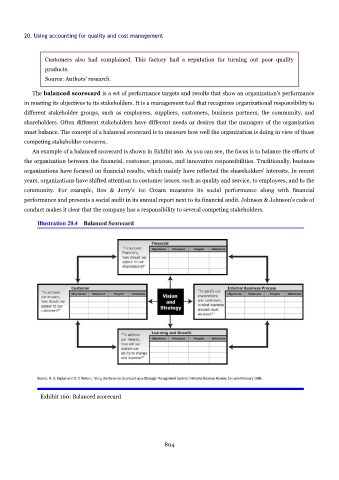Page 803 - Accounting Principles (A Business Perspective)
P. 803
20. Using accounting for quality and cost management
Customers also had complained. This factory had a reputation for turning out poor quality
products.
Source: Authors' research.
The balanced scorecard is a set of performance targets and results that show an organization's performance
in meeting its objectives to its stakeholders. It is a management tool that recognizes organizational responsibility to
different stakeholder groups, such as employees, suppliers, customers, business partners, the community, and
shareholders. Often different stakeholders have different needs or desires that the managers of the organization
must balance. The concept of a balanced scorecard is to measure how well the organization is doing in view of those
competing stakeholder concerns.
An example of a balanced scorecard is shown in Exhibit 160. As you can see, the focus is to balance the efforts of
the organization between the financial, customer, process, and innovative responsibilities. Traditionally, business
organizations have focused on financial results, which mainly have reflected the shareholders' interests. In recent
years, organizations have shifted attention to customer issues, such as quality and service, to employees, and to the
community. For example, Ben & Jerry's Ice Cream measures its social performance along with financial
performance and presents a social audit in its annual report next to its financial audit. Johnson & Johnson's code of
conduct makes it clear that the company has a responsibility to several competing stakeholders.
Exhibit 160: Balanced scorecard
804

